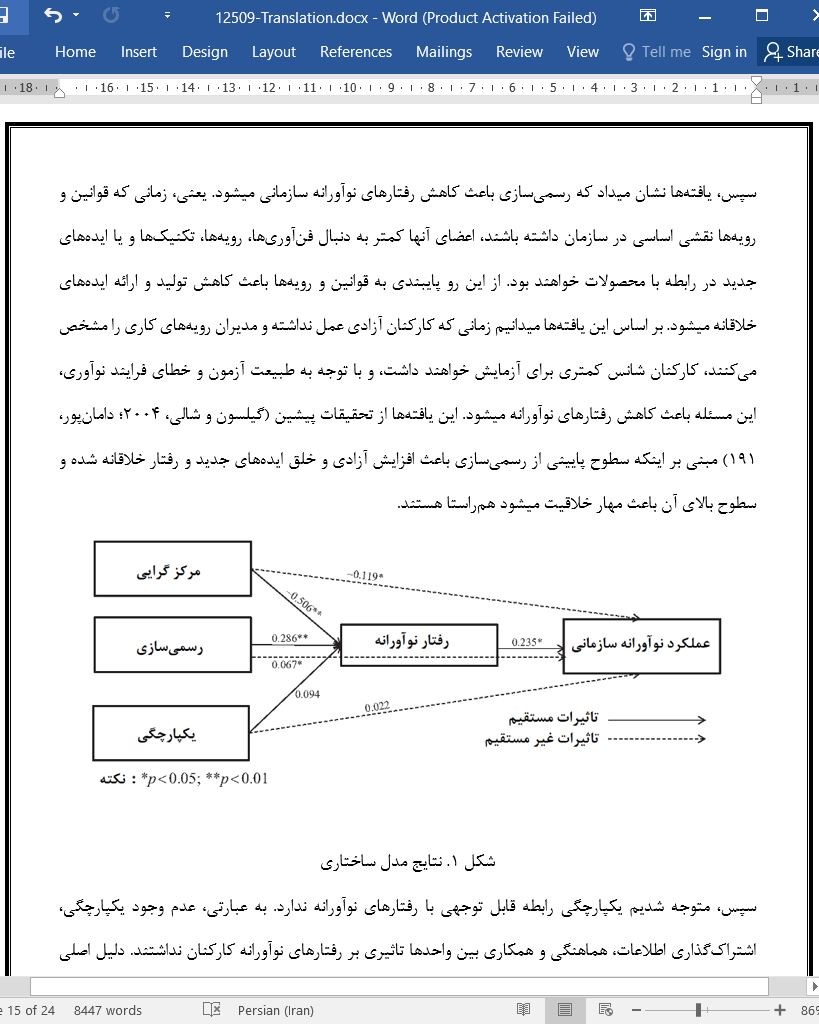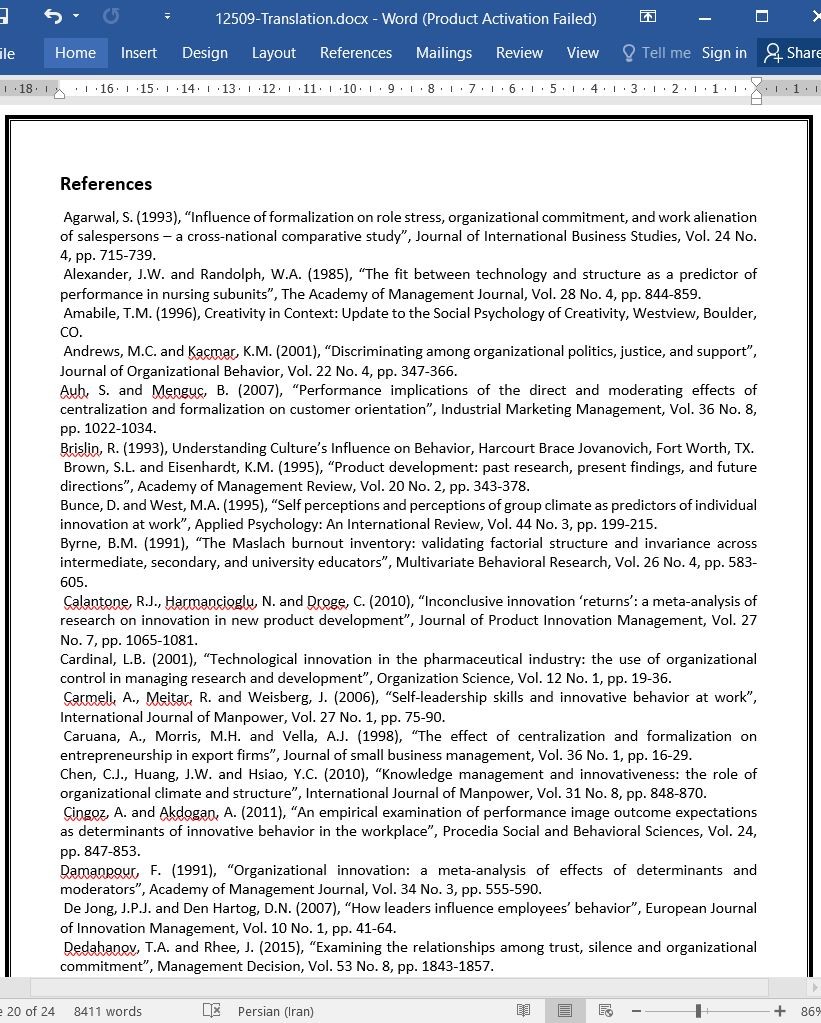
دانلود مقاله ساختار سازمانی و عملکرد نوآورانه: آیا رفتار نوآورانه کارکنان حلقه ای گمشده است؟
چکیده
هدف – هدف این مقاله بررسی نقش میانجی گرانه رفتارهای نوآورانه بر روابط بین ساختارهای سازمانی مانند مرکزگرایی، رسمی سازی، یکپارچگی و عملکرد نوآورانه سازمانی است.
طراحی/روش ها/رویکرد – مولفان داده ها را از 140 مدیر عملیاتی سازمان های تولیدی جمهوری کره جمع آوری کرده اند. مولفان از مدل معادلات ساختاری جهت ارزیابی اعتبار فرضیه های پیشنهادی استفاده کرده اند.
یافته ها – یافته ها حاکی از آن هستند که رفتارهای نوآورانه حلقه های بین مرکزگرایی، رسمی سازی و عملکرد نوآورانه را به هم متصل می کند. هرچند، یافته ها نشان می دهند که رفتارهای نوآورانه باعث ایجاد ارتباط میان یکپارچگی و عملکرد نوآورانه سازمانی نمی شود.
اصالت/ارزش – این اولین مقاله ای است که نقش میانجی گرانه رفتارهای نوآورانه در روابط بین مرکزگرایی، یکپارچگی، و عملکرد نوآورانه سازمانی را بررسی می کند.
مقدمه
نوآوری سازمانی یک عامل اساسی است که به بقای شرکت ها در یک دنیای درحال تغییر (پونت و همکاران، 2010) کمک می کند و همچنین یکی از ابزارهای کسب موفقیت و رقابت پذیری سازمانی (جافری، 2010) است، زیرا به سازمان ها کمک می کند تا عملکرد بهتری از رقبا داشته، مشتریان را هیجان زده کرده و پورتفولیوهای کالایی بهتری داشته باشند (جینگوز و آکدوگان، 2011). از این رو، سازمان های امروزی به ایده های خلاقانه و جدید از سوی کارکنانی که می توانند به عملکرد نوآورانه کمک کنند احتیاج بیشتری دارد. ما معتقدیم تنها سازمان ها از رفتار نوآورانه کارکنان بهره نمی برند، بلکه خود کارکنان نیز از خلاقیت خود سود می برند. افرادی که در فعالیت های خلاقانه شرکت می کنند می توانند شایستگی و تسلط خود را نیز بیشتر کنند (آمابیل، 1996). همچنین، افرادی که رفتارهای نوآورانه دارند به احتمال زیاد پاداش هایی برای رفتار خود دریافت کرده و ترقی می کنند (کیم و همکاران، 2009). همچنین، نوآوری کارکنان بر استفاده آنها از شبکه های اجتماعی و موقعیت اجتماعی آنان تاثیر می گذارد. بدلیل تقاضای بالای افراد مبتکر از سوی سازمان ها و تلاش سازمان ها جهت حفظ افراد مبتکر، اینگونه افراد در صورت تعدیل نیرو شانس بیشتری برای حفظ شغل های خود و یا پیدا کردن شغل های جدید دارند. بر این اساس، اهمیت نوآوری در سطح شخصی (جنسن و همکاران، 2006؛ نیر، 2014؛ تانگ و همکاران، 2013) و سازمانی در مطالعات پیشین (وودمن و همکاران، 1993؛ جنسن و همکاران، 2004؛ ون دو ون، 1986) ذکر شده است.
محدودیت ها و مسیرهای تحقیقاتی آتی
با وجود اینکه مقاله باعث افزایش دانش میشود، محدودیت هایی نیز دارد، به همین دلیل پیشنهاداتی برای تحقیقات آتی داریم، مقاله ما ابتدا به بررسی نقش میانجی گرانه رفتار نوآورانه بین سه عنصر از ساختارهای سازمانی (یعنی، مرکزگرایی، رسمی سازی، و یکپارچگی) و عملکرد نوآورانه سازمانی پرداخته است. از این رو، پیشنهاد میدهیم تحقیقات آتی، تاثیرات سایر عوامل ساختارهای سازمانی مانند تخصص کاری و بخش بندی بر اساس رفتار نوآورانه کارکنان و تاثیر آن بر عملکرد نوآورانه سازمانی را بررسی کنند. بعلاوه، ما در این مقاله، بر روی شکل کلی عملکرد نوآورانه سازمانی به جای انواع مختلف نوآوری سازمانی مانند بازار، محصول و نوآوری در رویه ها تمرکز کرده ایم. از این رو، پیشنهاد میدهیم که تحقیقات آتی، نقش میانجی گرانه رفتارهای نوآورانه کارکنان بر روی روابط بین مرکزگرایی، یکپارچگی و سایر انواع عملکردهای نوآورانه سازمانی مانند بازار، محصول و نوآوری در رویه ها را بررسی کنند. ما داده-های خود را تنها از شرکت های تولیدی جمع آوری کرده ایم و از این جهت یافته های ما ممکن است در سایر سازمان ها صادق نباشد. از این رو، پیشنهاد میدهیم تحقیقات آتی، اجرایی بودن این مدل در صنعت خدماتی را بررسی کنند.
Abstract
Purpose – The purpose of this paper is to investigate the mediating role of innovative behavior on the relationships between organizational structure, such as centralization, formalization, integration, and organizational innovation performance.
Design/methodology/approach – The authors collected data from 140 functional managers of manufacturing organizations in the Republic of Korea. The authors used structural equation modeling procedure to evaluate the validity of proposed hypotheses.
Findings – The results suggest that innovative behavior mediates the links among centralization, formalization, and organizational innovation performance. However, the findings indicate that innovative behavior does not mediate the relationship between integration and organizational innovation performance.
Originality/value – This work is the first to examine the mediating role of innovative behavior on the associations among centralization, integration, and organizational innovation performance.
Introduction
Organizational innovation is an underlying factor that assists companies to survive in a rapidly changing world (Pundt et al., 2010) and it is perceived to be one of the means of achieving organizational success and competitiveness ( Jafri, 2010) because it helps organizations outperform competitors, excite customers, and build new product portfolios (Cingoz and Akdogan, 2011). Thus, today’s organizations require more creative and novel ideas from employees who can contribute to innovation performance. We believe that it is not just organizations that benefit from employees’ innovative behavior but employees also benefit from their own innovativeness. Individuals engaging in creative activities have the chance to develop their competencies and task mastery (Amabile, 1996). What is more, individuals who display innovative behavior are more likely to receive rewards for their innovativeness and to be promoted (Kim et al., 2009). Moreover, the innovativeness of employees influences their social networking and social status (Greenberger and Strasser, 1986). Because there is a high demand for innovative individuals by organizations and every organization tries to retain innovative people, innovative individuals have a better chance to maintain their positions in the face of downsizing and find new jobs (Noe et al., 2011). Therefore, the significance of innovativeness at both the individual ( Jansen et al., 2006; Nayir, 2014; Tang et al., 2013) and organizational levels has been widely acknowledged by previous studies (Woodman et al., 1993; Janssen et al., 2004; Van de Ven, 1986).
Limitations and future research directions
Although our study extends the literature, it has several limitations and so we have made suggestions for future research. First, our study examined the mediating role of innovative behavior between three elements of organizational structures (i.e. centralization, formalization, and integration) and organizational innovation performance. Thus, we would suggest that future studies might investigate the impact of other elements of organizational structures, such as work specialization and departmentalization on employee innovative behavior, and whether this subsequently influences organizational innovation performance. Moreover, in our study, we focused on the general form of organizational innovation performance rather than various types of firms’ innovativeness, such as market, product and process innovation. Hence, we would recommend that future research should examine the mediating role of employee innovative behavior on the links between centralization, integration, and various types of organizational innovation performance such as market, product, and process innovation. Third, we only collected data from manufacturing companies, and thus our findings might not be transferable to organizations operating in other environments and industries. Therefore, we would recommend that future studies investigate the applicability of this model in the service industry.
H1. Centralization is negatively related to innovative behavior.
H2. Formalization is negatively related to innovative behavior.
H3. Integration is positively related to innovative behavior.
H4. Employee innovative behavior is positively related to organizational innovation performance.
H5. Innovative behavior mediates the link between centralization and organizational innovation performance.
H6. Innovative behavior mediates the link between formalization and organizational innovation performance.
H7. Innovative behavior mediates the link between integration and organizational innovation performance.
H1: مرکزگرایی دارای رابطه ای منفی با رفتار نوآورانه است.
H2 . رسمی سازی رابطه ای منفی با رفتار نوآورانه دارد.
H3 . یکپارچگی رابطه ای مثبت با رفتارهای نوآورانه دارد.
H4 : رفتارهای نوآورانه کارکنان رابطه ی مستقیمی با عملکرد نوآورانه سازمانی دارد.
H5 . رفتار نوآورانه باعث ایجاد ارتباط بین مرکزگرایی و عملکرد نوآورانه سازمان می شود.
H6 . رفتار نوآورانه باعث ایجاد ارتباط بین رسمی سازی و عملکرد نوآورانه سازمان می شود.
H7 . رفتار نوآورانه باعث ایجاد ارتباط بین یکپارچگی و عملکرد نوآورانه سازمان می شود.
Centralization
Formalization
Integration
Innovative behavior
Organizational innovative performance
چکیده
مقدمه
مروری بر تحقیقات پیشین
رفتار نوآورانه کارکنان
مرکزگرایی و رفتار نوآورانه
رسمی سازی و رفتار نوآورانه
یکپارچگی و رفتار نوآورانه
رفتارهای نوآورانه و عملکرد نوآورانه سازمانی
نقش میانجی گرانه رفتارهای نوآورانه
روش ها
داده ها و نمونه
معیارها
نتایج
تجزیه و تحلیل مدل برداری معادلات ساختاری
بحث
پیامدهای نظری
پیامدهای عملی
محدودیت ها و مسیرهای تحقیقاتی آتی
منابع
Abstract
Introduction
Literature review
Employee innovative behavior
Centralization and innovative behavior
Formalization and innovative behavior
Integration and innovative behavior
Innovative behavior and organizational innovation performance
The mediating role of innovative behavior
Methods
Data and sample
Measures
Results
Structural equation modeling analysis
Discussion
Theoretical implications
Practical implications
Limitations and future research directions
References
- اصل مقاله انگلیسی با فرمت ورد (word) با قابلیت ویرایش
- ترجمه فارسی مقاله با فرمت ورد (word) با قابلیت ویرایش، بدون آرم سایت ای ترجمه
- ترجمه فارسی مقاله با فرمت pdf، بدون آرم سایت ای ترجمه



